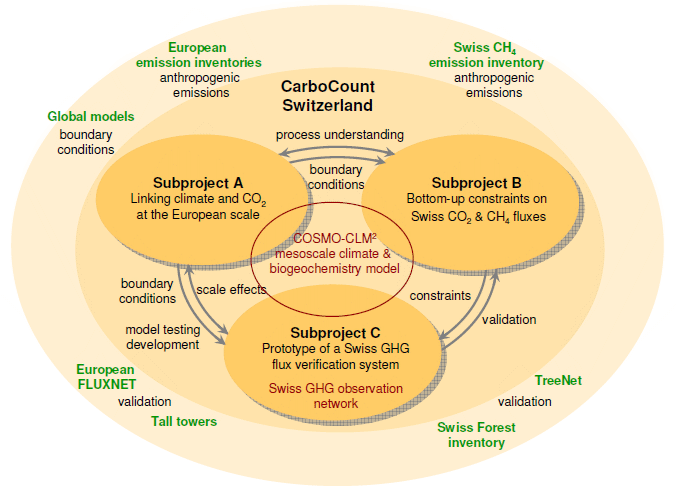Research Plan
The burning of fossil fuels emits vast amounts of CO2 to the atmosphere which is then partially absorbed by oceans and the biosphere which uses CO2 for the production of organic material through photosynthesis. Atmospheric CO2 is therefore increasing only about half as quickly as it would if all emitted CO2 remained in the atmosphere. It is highly uncertain, however, how the storage capacity of oceans and biosphere will evolve in the future under changing climatic conditions. CH4 is emitted from a variety of anthropogenic and natural sources and, similar to CO2, predictions of future CH4 levels are highly uncertain.
The project CarboCount CH will improve our understanding of biosphere-atmosphere exchange processes in a regional environment typical of the northern mid-latitudes. In addition, it will provide quantitative estimates of CO2 and CH4 fluxes in Switzerland through a unique combination of information from observations and models. These estimates will provide invaluable input to Swiss policy makers in the context of climate change, notably the Kyoto Protocol and ongoing post-Kyoto negotiations.
To achieve its goals, CarboCount CH will setup a network of four new atmospheric CO2 and CH4 measurement sites which will complement existing networks such as Swiss Fluxnet which measures biosphere-atmosphere exchange fluxes over selected vegetation types. The external pageBeromünster radio towercall_made will be the flagship of this network where CO2 and CH4 will be measured at several different altitudes above ground providing crucial data for flux estimation. The project will also explore new avenues in modeling: The weather forecast model external pageCOSMOcall_made, which is the regular forecast model of MeteoSwiss, will be extended with new modules to simulate transport of CO2 and CH4 in the atmosphere and to describe the exchange of CO2 between atmosphere and biosphere. Observations and model simulations will finally be combined in a so-called inverse modeling framework for a better quantification of greenhouse gas fluxes and emissions in Switzerland.

